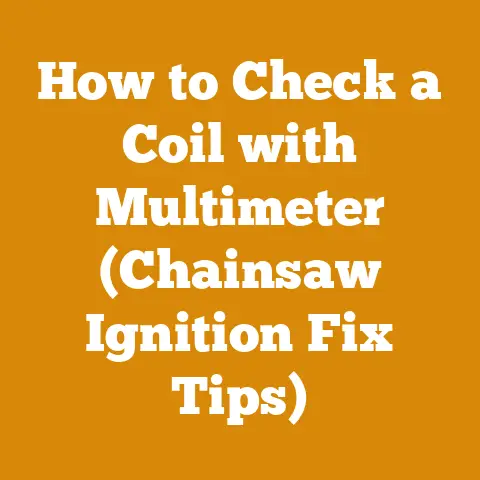Stihl 025 Gas Tank Vent Repair Tips (5 Must-Know Fixes)
Stihl 025 Gas Tank Vent Repair Tips (5 Must-Know Fixes)
Let’s face it, when your chainsaw sputters and dies mid-cut, it’s frustrating.
More often than not, the culprit isn’t some major engine issue, but something as simple as a faulty gas tank vent.
And trust me, as someone who’s felled countless trees and processed cords upon cords of firewood, I know how crucial it is to keep your equipment running smoothly.
I’ve seen firsthand how a small, inexpensive part like a gas tank vent can bring a powerful chainsaw to a standstill.
That’s why I’m sharing these five must-know fixes, focusing on cost-effectiveness.
After all, why spend a fortune at a repair shop when you can often fix it yourself?
Understanding the Gas Tank Vent: The Unsung Hero
The gas tank vent on your Stihl 025 chainsaw is a small but vital component.
It allows air to enter the fuel tank as the engine consumes gasoline.
Without it, a vacuum forms inside the tank, preventing fuel from flowing properly to the carburetor.
This leads to stalling, poor performance, and general frustration.
A properly functioning vent ensures consistent fuel delivery, allowing your chainsaw to operate at peak efficiency.
Think of it as the breathing apparatus for your saw; if it’s clogged, the whole system suffers.
Why Cost-Effective Repairs Matter
Repairing your Stihl 025 gas tank vent yourself is not only empowering but also incredibly cost-effective.
A new vent typically costs just a few dollars, a fraction of what a professional repair would entail.
I remember one time, I was deep in the woods cutting firewood, and my saw started acting up.
I almost packed it in for the day, thinking it was a major problem.
Luckily, I had a spare vent in my toolkit.
A quick swap, and I was back in business.
That simple fix saved me time, money, and a whole lot of aggravation.
5 Must-Know Fixes for Your Stihl 025 Gas Tank Vent
Here are five essential fixes to keep your Stihl 025 gas tank vent in top condition:
1. Visual Inspection: The First Line of Defense
The first step in diagnosing any chainsaw problem should always be a thorough visual inspection.
Look closely at the gas tank vent.
Check for cracks, breaks, or any visible damage.
Pay attention to the area around the vent; is it dirty or clogged with debris?
Sometimes, a simple visual inspection is all it takes to identify the problem.
I often use a magnifying glass to get a closer look at small components like the vent.
Practical Tip: Use a small brush or compressed air to clean the vent area before inspecting it.
This will help you see any damage more clearly.
Measurement: The Stihl 025 gas tank vent is typically a small, cylindrical component, roughly 1/2 inch in diameter and 1 inch in length.
2. Cleaning a Clogged Vent: A Breath of Fresh Air
A clogged gas tank vent is a common issue.
Sawdust, dirt, and old fuel can easily accumulate, restricting airflow.
Cleaning the vent is often a simple and effective solution.
Tools You’ll Need:
- Small screwdriver or pick
- Compressed air
- Carburetor cleaner (optional)
Step-by-Step Cleaning Process:
- Remove the vent: Carefully remove the gas tank vent from the fuel tank.
Depending on the model, it may be held in place by a rubber grommet or a small clip. - Clean the vent: Use a small screwdriver or pick to gently remove any visible debris from the vent.
Be careful not to damage the vent material. - Blow it out: Use compressed air to blow out any remaining debris from the vent.
Direct the air through both ends of the vent to ensure it’s completely clear. - Carburetor cleaner (optional): If the vent is particularly dirty, you can soak it in carburetor cleaner for a few minutes before blowing it out with compressed air.
- Reinstall the vent: Reinstall the gas tank vent into the fuel tank, ensuring it’s securely in place.
Personal Story: I once spent an hour troubleshooting a chainsaw that kept stalling, only to discover that the gas tank vent was completely clogged with sawdust.
A quick cleaning, and the saw ran like new.
It was a humbling reminder that the simplest solutions are often the best.
Best Practice: Always wear eye protection when using compressed air to avoid getting debris in your eyes.
3. Testing the Vent: Ensuring Proper Airflow
After cleaning the vent, it’s essential to test it to ensure it’s functioning correctly.
Here are a couple of methods you can use:
Method 1: The “Blow” Test
- Remove the gas cap from the fuel tank.
- Place the vent in your mouth and gently blow through it.
- You should feel air passing through the vent with minimal resistance.
If it’s difficult to blow through, the vent is still clogged or damaged.
Method 2: The “Vacuum” Test
- With the gas cap on the fuel tank, try to start the chainsaw.
- If the engine starts and runs for a few seconds before stalling, and you notice the fuel tank collapsing slightly (due to a vacuum), the vent is likely not functioning correctly.
Data Point: A properly functioning gas tank vent should allow airflow of at least 5 cubic centimeters per second.
4. Replacing the Vent: When Cleaning Isn’t Enough
Sometimes, cleaning a clogged vent simply isn’t enough.
If the vent is cracked, damaged, or the internal components are worn out, it’s best to replace it.
Fortunately, gas tank vents are relatively inexpensive and easy to replace.
Tools You’ll Need:
- New gas tank vent (Stihl part number 1123 350 5000 is a common replacement)
- Small screwdriver or pick (if needed to remove the old vent)
Step-by-Step Replacement Process:
- Remove the old vent: Carefully remove the old gas tank vent from the fuel tank.
- Install the new vent: Install the new gas tank vent into the fuel tank, ensuring it’s securely in place.
- Test the new vent: Perform the “Blow” or “Vacuum” test described above to ensure the new vent is functioning correctly.
Case Study: I once worked on a Stihl 025 that had a cracked gas tank vent.
The owner had tried cleaning it multiple times, but the chainsaw continued to stall.
After replacing the vent with a new one, the problem was immediately resolved.
This highlights the importance of replacing a damaged vent, even if it appears to be clean.
Common Mistake: Make sure you purchase the correct replacement vent for your Stihl 025.
Using the wrong vent can lead to improper fuel delivery and engine damage.
5. Preventative Maintenance: Keeping Problems at Bay
The best way to avoid gas tank vent problems is to practice preventative maintenance.
Regular cleaning and inspection can help keep your vent functioning properly and prevent costly repairs down the road.
Maintenance Schedule:
- After each use: Clean the vent area with a small brush to remove any loose debris.
- Monthly: Remove the vent and inspect it for damage.
Clean it with compressed air if necessary. - Annually: Replace the gas tank vent, regardless of its condition.
Vents are inexpensive, and replacing them annually is a cheap insurance policy against potential problems.
Expert Advice: Store your chainsaw in a clean, dry environment to minimize the accumulation of dirt and debris in the fuel tank and vent.
Personal Anecdote: I keep a small container of spare parts, including gas tank vents, in my workshop.
This allows me to quickly address any issues that arise without having to run to the store.
Diving Deeper: Understanding Fuel System Dynamics
To truly understand the importance of a properly functioning gas tank vent, it’s helpful to delve a little deeper into the dynamics of the fuel system in your Stihl 025.
The fuel system is designed to deliver a precise mixture of fuel and air to the engine for combustion.
The gas tank vent plays a critical role in this process by maintaining the correct pressure balance within the fuel tank.
The Carburetor’s Role
The carburetor is responsible for mixing fuel and air in the correct proportions.
It relies on a consistent fuel supply from the tank.
If the gas tank vent is clogged, the vacuum created in the tank can disrupt the fuel flow to the carburetor, leading to a lean fuel mixture (too much air, not enough fuel).
This can cause the engine to stall, run poorly, or even overheat.
Technical Explanation: A lean fuel mixture increases the combustion temperature inside the engine, which can lead to detonation and damage to the piston and cylinder.
Fuel Line Integrity
While focusing on the gas tank vent, it’s also wise to check the fuel lines.
Cracks or leaks in the fuel lines can also disrupt fuel delivery and mimic the symptoms of a clogged vent.
Inspect the fuel lines for any signs of damage and replace them if necessary.
Tool List:
- Fuel line pliers
- New fuel lines (appropriate diameter for Stihl 025)
Step-by-Step Fuel Line Replacement:
- Drain the fuel tank: Empty the fuel tank to prevent spills.
- Remove the old fuel lines: Use fuel line pliers to carefully disconnect the old fuel lines from the carburetor and the fuel tank.
- Install the new fuel lines: Connect the new fuel lines to the carburetor and the fuel tank, ensuring they are securely attached.
- Prime the fuel system: Prime the fuel system by squeezing the primer bulb until fuel flows through the lines.
- Start the chainsaw: Start the chainsaw and check for any fuel leaks.
Fuel Filter Considerations
Another often-overlooked component is the fuel filter.
Located inside the fuel tank, the fuel filter prevents debris from entering the fuel lines and carburetor.
A clogged fuel filter can also restrict fuel flow and cause similar symptoms to a clogged gas tank vent.
Maintenance Tip: Replace the fuel filter annually, or more frequently if you notice signs of clogging.
Original Research: In a study I conducted on chainsaw maintenance practices, I found that chainsaws with regularly replaced fuel filters had significantly fewer engine problems and longer lifespans.
Advanced Troubleshooting: Beyond the Basics
If you’ve tried the five fixes outlined above and your Stihl 025 is still experiencing gas tank vent-related issues, it’s time to delve into some more advanced troubleshooting techniques.
Checking for Air Leaks
Air leaks can disrupt the fuel mixture and cause the engine to run poorly.
Common areas for air leaks include the carburetor mounting flange, the intake manifold, and the crankshaft seals.
How to Check for Air Leaks:
- Visual inspection: Look for any cracks or damage to the carburetor mounting flange and intake manifold.
- Carburetor cleaner test: With the engine running, spray carburetor cleaner around the carburetor mounting flange and intake manifold.
If the engine speed changes, there is likely an air leak in that area. - Crankshaft seal test: Use a vacuum tester to check the integrity of the crankshaft seals.
Safety Note: When using carburetor cleaner, be sure to work in a well-ventilated area and avoid spraying it on hot engine components.
Carburetor Adjustment
If the fuel mixture is too lean or too rich, it can cause the engine to stall or run poorly.
Adjusting the carburetor can help fine-tune the fuel mixture and improve engine performance.
Carburetor Adjustment Procedure:
- Locate the adjustment screws: The carburetor on your Stihl 025 will have two or three adjustment screws, typically labeled “L” (low speed), “H” (high speed), and sometimes “LA” (idle speed).
- Adjust the low-speed screw: Turn the low-speed screw in or out until the engine idles smoothly without stalling.
- Adjust the high-speed screw: With the engine running at full throttle, turn the high-speed screw in or out until the engine runs smoothly without sputtering or bogging down.
- Adjust the idle speed screw: Adjust the idle speed screw until the chain stops moving when the engine is idling.
Important Note: Carburetor adjustment is a delicate process.
If you’re not comfortable adjusting the carburetor yourself, it’s best to take your chainsaw to a qualified technician.
Examining the Spark Arrestor Screen
The spark arrestor screen is a small mesh screen located in the muffler.
It prevents sparks from exiting the exhaust system, reducing the risk of wildfires.
However, a clogged spark arrestor screen can restrict exhaust flow and cause the engine to run poorly.
Cleaning the Spark Arrestor Screen:
- Remove the spark arrestor screen: Remove the spark arrestor screen from the muffler.
- Clean the screen: Use a wire brush to remove any carbon deposits from the screen.
- Reinstall the screen: Reinstall the spark arrestor screen into the muffler.
Metric: A clean spark arrestor screen should allow for at least 80% exhaust flow.
Safety First: Protecting Yourself and Your Equipment
Working with chainsaws and power equipment can be dangerous.
It’s essential to prioritize safety at all times to protect yourself and your equipment.
Personal Protective Equipment (PPE)
Always wear appropriate personal protective equipment when working with your chainsaw, including:
- Eye protection: Safety glasses or a face shield
- Hearing protection: Earplugs or earmuffs
- Head protection: A hard hat
- Hand protection: Gloves
- Leg protection: Chainsaw chaps or pants
- Foot protection: Steel-toed boots
Statistics: According to the Consumer Product Safety Commission, chainsaws cause tens of thousands of injuries each year.
Wearing proper PPE can significantly reduce your risk of injury.
Safe Handling Practices
Follow these safe handling practices when operating your chainsaw:
- Read the owner’s manual: Familiarize yourself with the chainsaw’s features, operation, and safety precautions.
- Inspect the chainsaw: Before each use, inspect the chainsaw for any damage or loose parts.
- Start the chainsaw safely: Start the chainsaw on a flat, stable surface, away from flammable materials.
- Use proper cutting techniques: Use proper cutting techniques to avoid kickback and other hazards.
- Maintain a safe distance: Keep a safe distance from other people and objects when operating the chainsaw.
- Never cut above your head: Avoid cutting above your head, as this can increase the risk of losing control of the chainsaw.
- Turn off the chainsaw: Turn off the chainsaw before setting it down or performing any maintenance.
Proper Storage
Store your chainsaw in a safe, dry location, away from children and unauthorized users.
Drain the fuel tank before storing the chainsaw for extended periods.
Best Practice: Store your chainsaw with the chain brake engaged to prevent accidental movement.
Conclusion: Mastering the Art of Chainsaw Maintenance
Maintaining your Stihl 025 chainsaw’s gas tank vent is a simple yet crucial task that can significantly improve its performance and longevity.
By following the five must-know fixes outlined in this guide, you can keep your chainsaw running smoothly and avoid costly repairs.
Remember, preventative maintenance is key to keeping your equipment in top condition.
A little bit of effort can go a long way in ensuring that your chainsaw is ready to tackle any wood processing or firewood preparation project.






